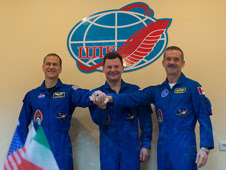Final launch preparations are under way at the Baikonur Cosmodrome in Kazakhstan as three new Expedition 34 crew members are ready to begin a two-day journey to join their crewmates aboard the International Space Station.
Flight Engineers Tom Marshburn, Roman Romanenko and Chris Hadfield are set to launch aboard their Soyuz TMA-07M spacecraft at 7:12 a.m. EST (6:12 p.m. Baikonur time) Wednesday from the Baikonur Cosmodrome, Kazakhstan.
The new trio will join current station residents Commander Kevin Ford and Flight Engineers Oleg Novitskiy and Evgeny Tarelkin when they dock their Soyuz to the Rassvet module at 9:12 a.m. Friday.
Meanwhile aboard the orbiting laboratory, Ford, Novitskiy and Tarelkin were busy with a variety of science experiments and maintenance duties Tuesday as they await the launch and arrival of their crew mates.
Source: http://www.nasa.gov
Flight Engineers Tom Marshburn, Roman Romanenko and Chris Hadfield are set to launch aboard their Soyuz TMA-07M spacecraft at 7:12 a.m. EST (6:12 p.m. Baikonur time) Wednesday from the Baikonur Cosmodrome, Kazakhstan.
The new trio will join current station residents Commander Kevin Ford and Flight Engineers Oleg Novitskiy and Evgeny Tarelkin when they dock their Soyuz to the Rassvet module at 9:12 a.m. Friday.
Meanwhile aboard the orbiting laboratory, Ford, Novitskiy and Tarelkin were busy with a variety of science experiments and maintenance duties Tuesday as they await the launch and arrival of their crew mates.
Source: http://www.nasa.gov




